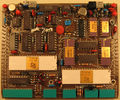7L18
The Tektronix 7L18 is a spectrum analyzer plug-in introduced in 1978 for 7000-series scopes. It occupies three plug-in bays in the oscilloscope.
Key Specifications
| Frequency range | 1.5 GHz to 18 GHz with the internal mixer, 12.5 GHz to 60 GHz using external mixers |
|---|---|
| Frequency span | 0; 200 Hz/Div to 500 MHz/Div in 1−2−5 steps; Max (see note below) |
| Resolution bandwidth | 30 Hz to 3 MHz in decade steps |
| Vertical scale | 10 dB/Div, 2 dB/Div, or linear |
| Input attenuator | 0 dB to 60 dB in 10 dB steps |
| Sweep | 1 μs/Div to 20 s/Div, auto, ext, or manual |
| Digital functions | two memory banks (A, B); Display A, B - A saved, peak hold |
Please expand
Context
Linley Gumm says:
Another disappointment was the 7L18 microwave analyzer project, one of the earliest Tek products to have a microprocessor in it.
"We started work on developing this product in 1974, and finally shipped our first instrument in 1978. As I look back, it was a terribly crude microprocessor, and we made every error in the book. Of course, we didn't have any of the tools that are available today."
Although the 7L18 never did sell well, Linley and his crew developed components and technologies that later were used in the 492. (TekWeek March 27, 1987)
Internals
The LO is a YIG tuned oscillator covering the 2 GHz to 4 GHz range. Its output passes through a sampler assembly used to PLL the YIG on small resolution bandwidths. The output of the sampler goes to the LO input on the mixer. The mixer IF output is 510 MHz.
The 7L18's components are controlled by an Intel 4004 4-bit microprocessor.
The 7L18 will NOT do 1.5 GHz to 18 GHz in one span, it will only max span the range selected by the BAND/HARMONIC control. This range is determined by the heterodyne harmonic number and sign (sideband) and the range of the first LO, which is 2 GHz to 4 GHz.
The input attenuator is a standard Weinschel Engineering product driven by a belt. The range is encoded for the digital dBm reference level display. The signal then passes through a YIG preselector filter with a 50 MHz bandwidth. After the YIG filter, the signal enters the RF input of the mixer assembly.
Links
- TekScope Vol. 9 No. 3, 1977
- Spectrum Analysis Using Waveguide Mixers (PDF)
- Waveguide Mixers for 492 and 7L18
Pictures
Service views:
-
Top view
-
Bottom view
-
Service setup for the right front panel
Boards within the digital card cage (from back to front):
-
CRT Readout board
-
Center Freq Readout board
-
Sweep Horiz board
-
Span Atten board
-
Phase Lock module, rear
-
Phase Lock module, front
-
Phase Lock Logic CTL
-
VR Noise Filter
-
Log & Video Amp
-
Center Freq DVM
-
Digital Storage, front
-
Digital Storage, back
-
Micro Computer
The microcomputer board is built using three very old Intel chips: an Intel 4004 processor, an Intel 4002 320-bit RAM and 4-bit output port, and an Intel D4289 standard memory interface. The D4289 connects the 4004 to the two 2K8 ROMs. Note that in an earlier version of the 7L18 there were 6 ROMs.
Internal views of the analog parts:
-
Internal of the LO sampler





























